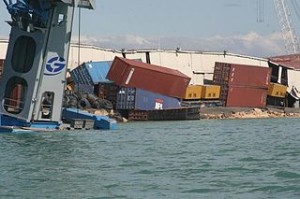More often than not, when (natural) disaster happens, the problem is not the willingness of the world community to help. What hinders a quick support for the people in need is more the logistics infrastructure (most of the time at least damaged if not destroyed by the disaster at hand) and missing corresponding logistics concepts to get the best performance by using what is left. Since 2010 BVL is working on the topic of Humanitarian Logistics by means of dedicated councils. The most recent findings have been published in the last quarter of 2013. First tangible results have been achieved. Daniel Link, who was a highly committed member of BVL International’s Humanitarian Logistics Council and who is doing continuous research on the topic, sent me a summary of the interesting but quite long article “Get seaports ready for desaster” which I would herewith like to recommend and present. He wrote the original article together with James F. Smith of AmericasRelief Team and Ferdinand Moehring of BLG LOGISTICS. Find the long version here: http://www.monthlydevelopments.org/article/making-ports-more-resilient

“Coast Guard crewmembers photographed tumbling shipping containers at Port-au-Prince Jan. 13, 2010. Coast Guard personnel arrived in Haiti to assess damage to the ports and waterways after an earthquake ravaged the island Jan. 12, 2010. U.S. Coast Guard photo.” (Text From U.S. Coast Guard)
Seaports and airports play a significant role to deliver international humanitarian assistance during disasters, as they channel most of the required personnel, equipment and supplies that is brought into the affected country. For example, international response to the food crisis in East Africa from 2007 to 2012 relied on the ports of Mombasa, Djibouti and Port Sudan with last mile transports being realized with 20-30 metric ton trucks.
Both seaports and airports represent complex systems that comprise various modes of transportation and communication, with many employees on site. Moreover, they are based on large public and private investments and are often part of the public image of their cities or nations. Regardless of type, ports are vulnerable to and need to be made resilient against physical damage, disturbances of operations, demand exceeding capacity, and lack of specialized equipment. Civil disorder and epidemics are further factors to be considered. Ports that are used for relief efforts can be situated within the area that is affected by a disaster or far away from it.
Efforts aimed at attaining port resilience fall into five general categories: policy, organizational (relationships), procedural, structural, and defensive. Resiliency measures that cut across the first three categories are – protection of key employees and their families and creation of priority plans for competing use in case a port is stressed by disaster relief efforts. Any effective attempt to improve port resilience requires interaction among many partners, i.e. owners and operators of the port, its regulators, the financial sector, normal users of the port and humanitarian organizations; hence public-private partnerships have great advantages for port resiliency.
Existing approaches that aim to improve port resiliency are Deutsche Post DHL’s “Get Airports Ready for Disaster” (GARD) for airports, BVL International’s “Get Seaports Ready for Disaster” (GSRD) for seaports, and AmericasRelief Team’s Port Resiliency Program (PReP) for airports and seaports. These programs are covered in greater detail in the book Managing Humanitarian Supply Chains – Strategies, Practices and Research, published in October 2013. The book contains the results from the second cycle of BVL International’s Humanitarian Logistics Council. Find more about the book at http://www.bvl.de/en/knowledge/publications/series


Leave a Reply